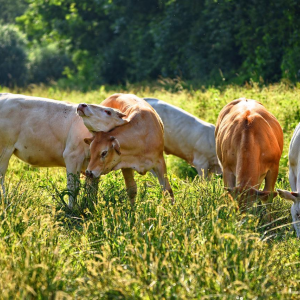
TABLE community member Matthew Jordon has co-authored this study, which finds that two practices linked to regenerative agriculture are linked to higher productivity: rotational grazing, where animals are frequently moved around pastures to allow areas to recover from grazing, and herbal leys, where multiple species of perennial flowering plants are grown as part of the pasture. The study focuses on sheep and cattle in temperature climates, and analyses data from 84 articles identified in the literature.
The results show that the greater the proportion of time that pasture is able to rest during grazing season (through rotational grazing), the higher the production of plant dry matter. At low stocking densities, the proportion of rest time has little influence on the daily weight gain of livestock (because livestock growth is not limited by forage availability in this case); at higher stocking densities, higher proportions of rest time are positively correlated with higher daily livestock weight gains.
Abstract
Reducing greenhouse gas emissions associated with ruminant livestock production is important for climate change mitigation. Regenerative Agriculture (RA) practices are increasingly promoted to improve forage production and livestock performance in temperate livestock systems. These practices include i) rotational grazing (RG) of livestock around multiple subunits of pasture to achieve ungrazed periods of ‘rest’, and ii) herbal leys (HL), where perennial forbs such as chicory, lucerne and trefoils are included as components in multi-species swards. While there are plausible mechanisms for adoption of these practices to improve agricultural productivity, quantitative syntheses of their impacts are required. Here, we conduct a systematic review and meta-analysis of the effects of RG and HL practices on herbage dry matter (DM) production, animal daily liveweight gain (DLWG), and sheep wool growth in temperate oceanic regions. We use quantitative predictors in our Bayesian hierarchical models to investigate the role of rest period and stocking density in RG systems, and specific plant traits and sward diversity in HL. We found that herbage DM increased by 0.31 t.ha−1 over a growing season as the proportion of rest in an RG grazing system increased from 0 to 1. Stocking density significantly moderated the effect of rest period on sheep and cattle DLWG; at higher stocking densities, longer rest periods were required to maintain livestock growth rates. In HL studies, herbage DM yielded 1.63 t.ha−1 more per metre of increased sward root depth and a sward entirely comprised of legumes yielded 2.20 t.ha−1 more than when no legumes were present. Sheep DLWG increased by 3.50 g.day−1 per unit increase in leaf nitrogen concentration (mg.g−1), but we could not determine an effect of leaf condensed tannin content on animal performance. Although there remain differences between the RG and HL study treatments meta-analysed here and RA in practice, our results provide empirical support for some of the mechanisms attributed to increased pasture and livestock productivity following adoption of selected RA grazing practices.
Reference
Jordon, M.W., Willis, K.J., Bürkner, P.C. and Petrokofsky, G., 2022. Rotational grazing and multispecies herbal leys increase productivity in temperate pastoral systems–A meta-analysis. Agriculture, Ecosystems & Environment, 337, p.108075.
Read the full paper here. See also the TABLE explainer How can we reduce food-related greenhouse gas emissions? and the blog post The challenge of making UK ruminant production sustainable by Matt Jordon.







Post a new comment »